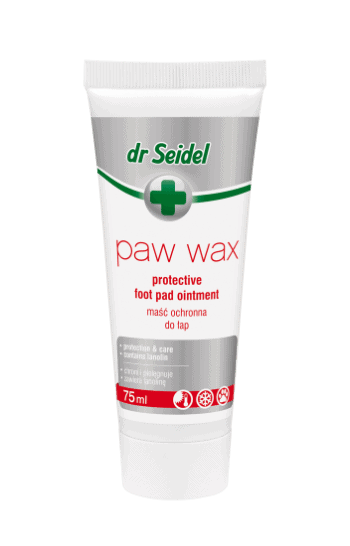Care of the dogs’ paws in winter
Care of the dogs’ paws in winter
The coming season is not very friendly for dog paws and long walks. This is why we should take special care of the condition of the pet’s pads, claws and coat between the pads during the winter.

Soon, the first snow will fall and with it the salt will be sprayed on the pavements and streets. There is nothing worse than cracked skin that comes into contact with salt. To counteract this, the dog’s pads should be lubricated with a greasy ointment, e.g. Paw Wax, containing lanolin, so that the skin is not dry and there are no micro-cracks.
Regular care of the pads will ensure that they are properly moisturised and will not cause problems in winter. In addition, after each winter walk, wash your dog’s paws with warm water to rinse away any salt and sand particles, and the reapply the moisturising ointment. Failure to do so will cause the animal to try to get rid of the salt by licking its paws, which can lead to its poisoning. There is coat between the pads, which must be removed so that no ice balls form due to the snow. Such a care treatment should be performed by a professional groomer 2–3 times in the winter season or by you, carefully cutting the protruding hair between the pads.
Another element of the dog’s paw that we have to take special care of is the claws. Shortened to the right length will provide stability on slippery ground. We should remember that walks should not be too long and that the animal should be in constant motion. If possible, let’s also choose a place for walks in the parks, not along the streets where there will be most salt and sand.
Also, supplementation with omega acids (Flawitol Omega Complex) and zinc is helpful in maintaining the skin in good condition. These two ingredients in the dog’s diet will ensure the proper regeneration and appearance of the whole skin and hair coat of the animal. In extremely difficult conditions, you can also try the special dog shoes available on the market, which completely isolate the skin from the icy surface. Unfortunately, most dogs do not accept this solution because the shoes they wear disturb their perception of the surface they are standing on. The paws then fall apart, the walk is unstable and the dog tries to take them off. If you decide to do this, you should get your dog used to putting on and wearing shoes much earlier.
Only well-groomed and well cared for paws will be the basis of the animal’s comfort, giving it stability on difficult terrain and comfort of movement; therefore the treatments described above should be a daily routine during the winter.
Veterinarian Monika Wieczorek-Smolarek
28 January 2020


